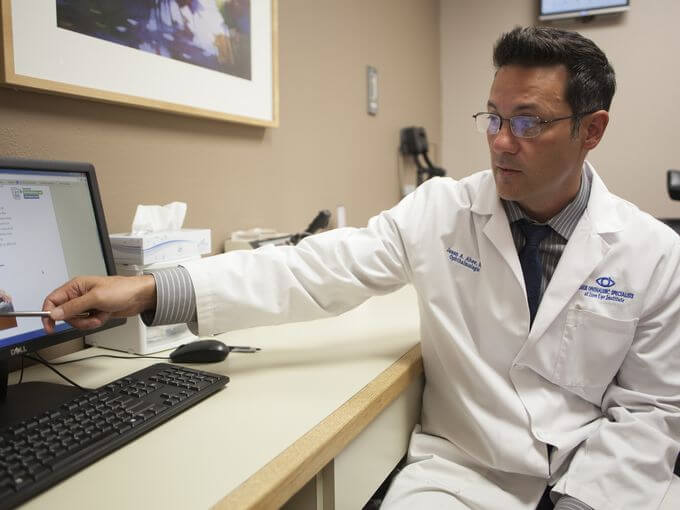Article courtesy of The Spectrum.
Author: Jud Burkett, jburkett@thespectrum.com

Imagine a blind spot right in the middle of your vision. As you look at these words presented to you either in the newspaper or on the screen of a mobile device or a computer, picture the center of your vision, rather than being filled with letters your brain can form into words, it is filled with gray shapes and swirls. Imagine having to try and use your peripheral vision instead to read.
Give it a try, right now, focus your eyes off to the side of the paper or the computer, don’t look directly at the words, and try to read. It’s challenging, if not impossible.
More than 15 million Americans dealing with age-related macular degeneration, or AMD, don’t have to imagine what it’s like, they live with the reality of losing the center of their vision every day.
Until recently, once this condition reached its end-stage, there was no way to correct this form of blindness. There were no drugs, no surgeries, no glasses that could give those dealing with this condition any form of relief.
However, in 2010, the Food And Drug Administration gave approval to a radical new treatment for end-stage AMD that involves the implantation of a tiny telescope into the eye.
“It’s similar to cataract surgery, but it’s more involved than cataract surgery,” said Dr. Jayson Edwards, the surgeon at Dixie Ophthalmic Specialists at Zion Eye Institute who was the first to perform the surgery here in St. George earlier this summer. “The main difference is the incision size is quite a bit bigger because it’s a bigger implant.”
There is a long list of criteria a patient must fit in order to be eligible of the implant: they must be over the age of 65; they can’t have had any previous cataract surgeries and must still have their natural lenses in their eyes; the degeneration of their vision must have stabilized; and they must be able to pass a series of cognitive and vision tests.
“They call it end-stage because it’s as bad as you can get,” said Dr. Jason Ahee, the executive director of the Zion Eye Institute. “These are not very common. The majority of patients who are identified for possible implant don’t make it through the complete selection process. It’s pretty rigorous criteria.”
But for those who pass the pre-screening, the device can have an enormous impact on their lives.
“Things that we take for granted that are impossible if you had both eyes with a blind spot in the middle — if we can get them to even be able to play solitaire on their computer for example, that’s a big deal for these people,” said Ahee. “It’s important to have realistic expectations. If you lost your driver’s license because you’re legally blind, it’s not going to get you your license back, but gaining three to four lines on the eye chart, (being able to do) daily tasks like reading, watching TV, cooking, paying bills — some of these smaller tasks — can make a big difference to people.”

“It’s not going to give you 20/20 vision, but if we can help people gain a little bit of independence, that’s what we’re trying to find,” said Edwards.
The miniature telescope, once placed inside the eye, magnifies the patient’s vision by a factor of about 2.5 times.
“The telescope magnifies what you’re looking and it reduces the impact of the blind spot,” said Ahee. “It magnifies what you’re looking at so you can see it around the blind spot. The blind spot is still there, there’s just not as much of an impact because it’s only blocking out a part of the image.”
Once the device is implanted, there is a learning curve when it comes to using the telescope. “They have to go through occupational therapy; they give them exercises to do; they have to go home and practice. From a surgical standpoint, (recovery) only takes a couple of weeks, but it will take several weeks to several months to fully recover and to use the technology,” said Ahee.
“Just like when you look through binoculars or a telescope, you lose that peripheral vision,” said Edwards. “But you still have your other eye; the two eyes helps each other out. They train their brain to see with one eye.
So far, the team at Zion Eye Institute has only had one patient undergo the procedure, but they are hoping to be able to help more patients with AMD in the very near future.
“The first one we did went pretty well, we were happy with the outcome,” Ahee said. “From a clinical standpoint, she’s doing really good, her vision has improved with the implant, and she seems to be happy about it. We hope she’ll improve even more with her (occupational therapy) sessions.”
While the having the tiny telescope implanted is costly, Ahee says the procedure is now covered by Medicare.
“It’s a nice feather in our cap,” Ahee said. “We’re the biggest and best facility in St. George, so it’s up to us to do these more advanced technologies. It took awhile, but it’s definitely worth it. The fact that they can make a telescope that fits inside of your eyeball, the technology is pretty neat. We’re hoping that it helps out a lot of people.”
Follow Jud Burkett on Twitter and Instagram @judburkett. Email him at jburkett@thespectrum.com or call him at 435-674-6262.
